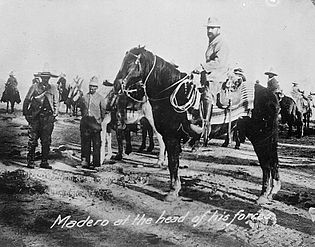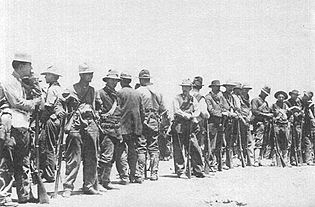This article has multiple issues. Please help improve it or discuss these issues on the talk page. (Learn how and when to remove these template messages)
|
| Border War | |||||||
|---|---|---|---|---|---|---|---|
| Part of the Mexican Revolution, Banana Wars and World War I | |||||||
| |||||||
| Belligerents | |||||||
|
Supported by: |
| ||||||
| Commanders and leaders | |||||||
|
Álvaro Obregón Venustiano Carranza Pancho Villa Felipe Ángeles Aniceto Pizana Luis de la Rosca |
Herbert J. Slocum John J. Pershing Frank Tompkins Frederick J. Herman | ||||||
| Casualties and losses | |||||||
|
867 soldiers, militia, and insurgents killed[a] 400+ civilians killed[b] |
123 soldiers killed 427 civilians killed[14] | ||||||
The Mexican Border War,[15] also known as the Border Campaign,[16] refers to a series of military engagements which took place between the United States military and several Mexican factions in the Mexican–American border region of North America during the Mexican Revolution.
The Mexican Border War was the fifth and last major conflict fought on U.S. soil, its predecessors being the American Revolutionary War, the War of 1812, the Mexican–American War (1846–1848), and the American Civil War. The end of the Mexican Revolution on December 1, 1920, marked the close of the American Frontier, although the American Indian Wars went on for another four years. The Bandit War[17] in Texas was part of the Border War.
From the beginning of the Mexican Revolution in 1910, the United States Army was stationed in force along the border and, on several occasions, fought with Mexican rebels or regular federal troops. The height of the conflict came in 1916 when revolutionary Pancho Villa attacked the American border town of Columbus, New Mexico. In response, the United States Army, under the direction of General John J. Pershing, launched a punitive expedition into northern Mexico, to find and capture Villa. Although Villa was not captured, the US Army found and engaged the Villista rebels, killing Villa's two top lieutenants. The revolutionary himself escaped, and the American army returned to the United States in January 1917.
Conflict at the border continued, however, and the United States launched several smaller operations into Mexican territory until after the American victory in the Battle of Ambos Nogales in August 1918, which led to the establishment of a permanent border wall.[18] Conflict was not limited to battles between Villistas and Americans; Maderistas, Carrancistas, Constitutionalistas and Germans also engaged with American forces in that period.
The German Empire, a major trading partner with Mexico and a rival of the United States and its allies, occasionally appeared in the conflicts between the United States and Mexican forces during the Mexican Revolution. In 1914, the United States occupied Veracruz, aiming to cut off supplies of ammunition from the German Empire to Mexico at the start of World War I. In 1917, the British government intercepted a German telegram which offered the Mexican President financial support in recapturing the territories acquired by the United States through the Texas annexation and the Mexican Cession. In exchange, the German Empire wanted Mexico's formal support in anticipation of a hypothetical United States entry into the war in Europe. While the offer was not accepted, a small German military presence could be observed in later battles along the border, such as the Battle of Ambos Nogales.
- ^ Parra, "Valientes Nogalenses", 16-17.
- ^ Parra, "Valientes Nogalenses", 23–24.
- ^ "Chasing Pancho Villa: The US Punitive Expedition". Archived from the original on 10 February 2017.
- ^ "Memoria PolÃtica de México".
- ^ http://sistemas.iibi.unam.mx/cheran/archivospdf/020._Villa_y_la_expedicion_punitiva.pdf [bare URL PDF]
- ^ a b Pershing Report, October 1916, Appendix M (General Orders, No. 1)
- ^ Beede, Benjamin R. (1994). The War of 1898, and U.S. interventions, 1898–1934: an encyclopedia, Taylor & Francis, p. 325.
- ^ Rosales, Francisco A. (1999). Pobre raza!: violence, justice, and mobilization among México Lindo immigrants, 1900-1936. University of Texas Press. p. 15
- ^ de Quesada, Alejandro (March 2012). The Hunt for Pancho Villa: The Columbus Raid and Pershing's Punitive Expedition. Osprey Publishing. p. 12.
- ^ Finley, James P. (1996). Buffalo Soldiers at Huachuca: The Battle of Ambos Nogales. Fort Huachuca, AZ: Huachuca Museum Society. p. Vol. 2, part 6. ISBN 978-1-112-14467-7. Retrieved 18 January 2010. Note: Library of Congress Number: 93-206790.
- ^ Gastón García Cantú (1996). Las invasiones norteamericanas en México (in Spanish). México: Fondo de Cultura Económica. p. 276.
- ^ Alan McPherson (2013). Encyclopedia of U.S. Military Interventions in Latin America, p. 393, ABC-CLIO, USA.
- ^ Finley, Vol. 2, part 6
- ^ John Boessenecker. "Texas Ranger: The Epic Life of Frank Hamer, the Man Who Killed Bonnie and Clyde." Thomas Dunne Books (26 April 2016). Page 134.
- ^ Weber, pg. 84
- ^ "Mexican Border Campaign Veterans' Card File Indexes". digitalarchives.state.pa.us. Archived from the original on 27 July 2011. Retrieved 3 August 2011.
- ^ "Raiders attack Norias Division of King Ranch". Archived from the original on 19 February 2014. Retrieved 10 November 2011.
- ^ "August 27, 1918: The Battle of Ambos Nogales brings the Fence to the Border | The Daily Dose".
Cite error: There are <ref group=lower-alpha> tags or {{efn}} templates on this page, but the references will not show without a {{reflist|group=lower-alpha}} template or {{notelist}} template (see the help page).










